Research Proposal: Building Brand Identity on Social Media Platforms
VerifiedAdded on 2023/01/04
|13
|2860
|98
Report
AI Summary
This report outlines a comprehensive research proposal focused on the critical topic of brand identity within the dynamic landscape of social media. The proposal begins with an introduction highlighting the significance of brand identity and its evolution in the digital age, followed by clearly defined aims and objectives, and specific research questions. A conceptual framework provides a foundation, defining key terms like "brand identity" and "social media marketing." The literature review explores existing research on brand identity application, the implications of social media on business, and the effects of social media on consumer buying decisions, supported by numerous scholarly sources. The research plan details the methodology, including the research philosophy, design, data collection methods (surveys, case studies, and online statistics), and sampling techniques. The proposed timeline, presented as a Gantt chart, offers a structured approach to the research process. The report concludes by emphasizing the importance of the research and its potential contributions to marketing practices, providing a valuable resource for students and professionals seeking to understand and leverage social media for brand building.
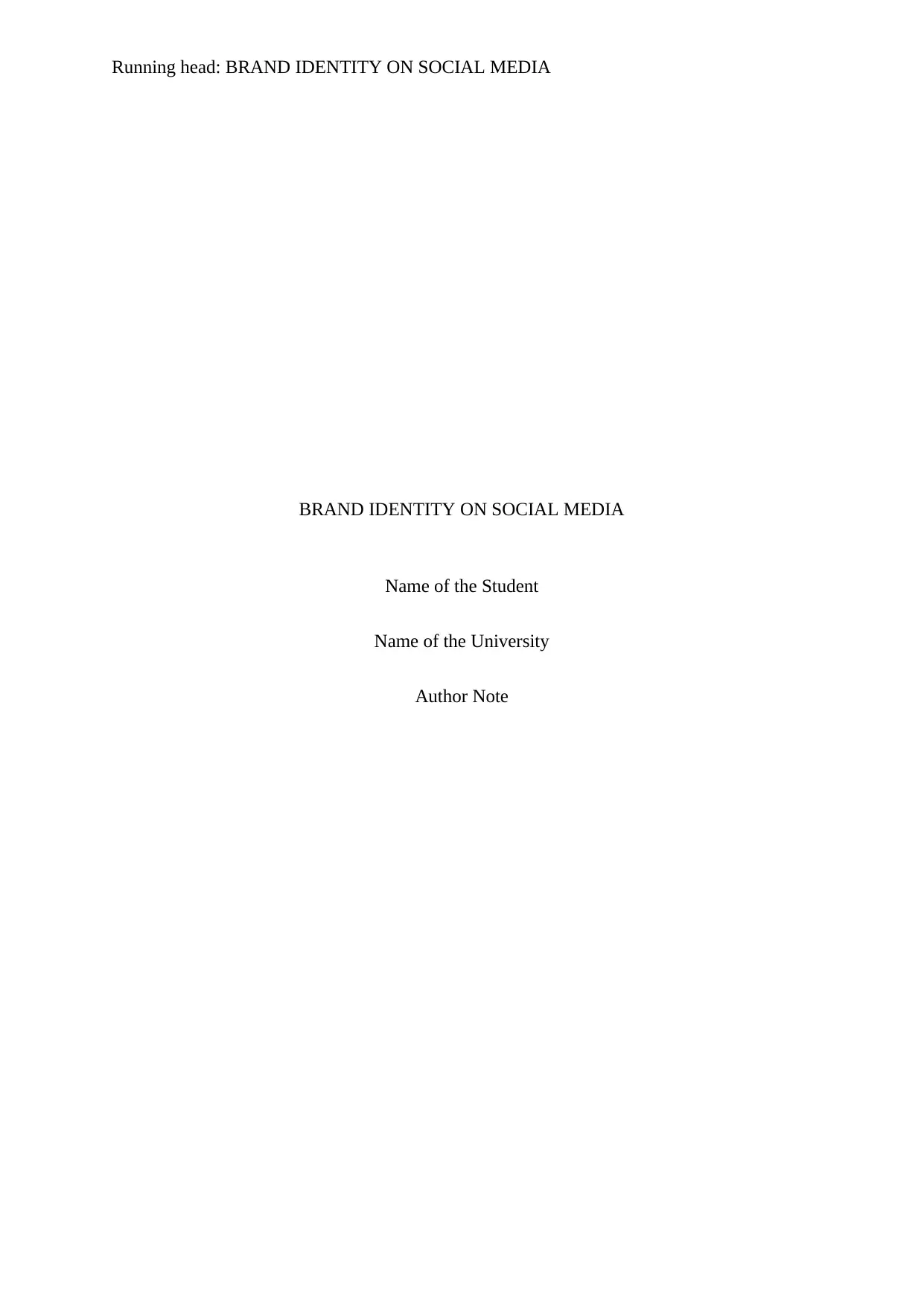
Running head: BRAND IDENTITY ON SOCIAL MEDIA
BRAND IDENTITY ON SOCIAL MEDIA
Name of the Student
Name of the University
Author Note
BRAND IDENTITY ON SOCIAL MEDIA
Name of the Student
Name of the University
Author Note
Paraphrase This Document
Need a fresh take? Get an instant paraphrase of this document with our AI Paraphraser
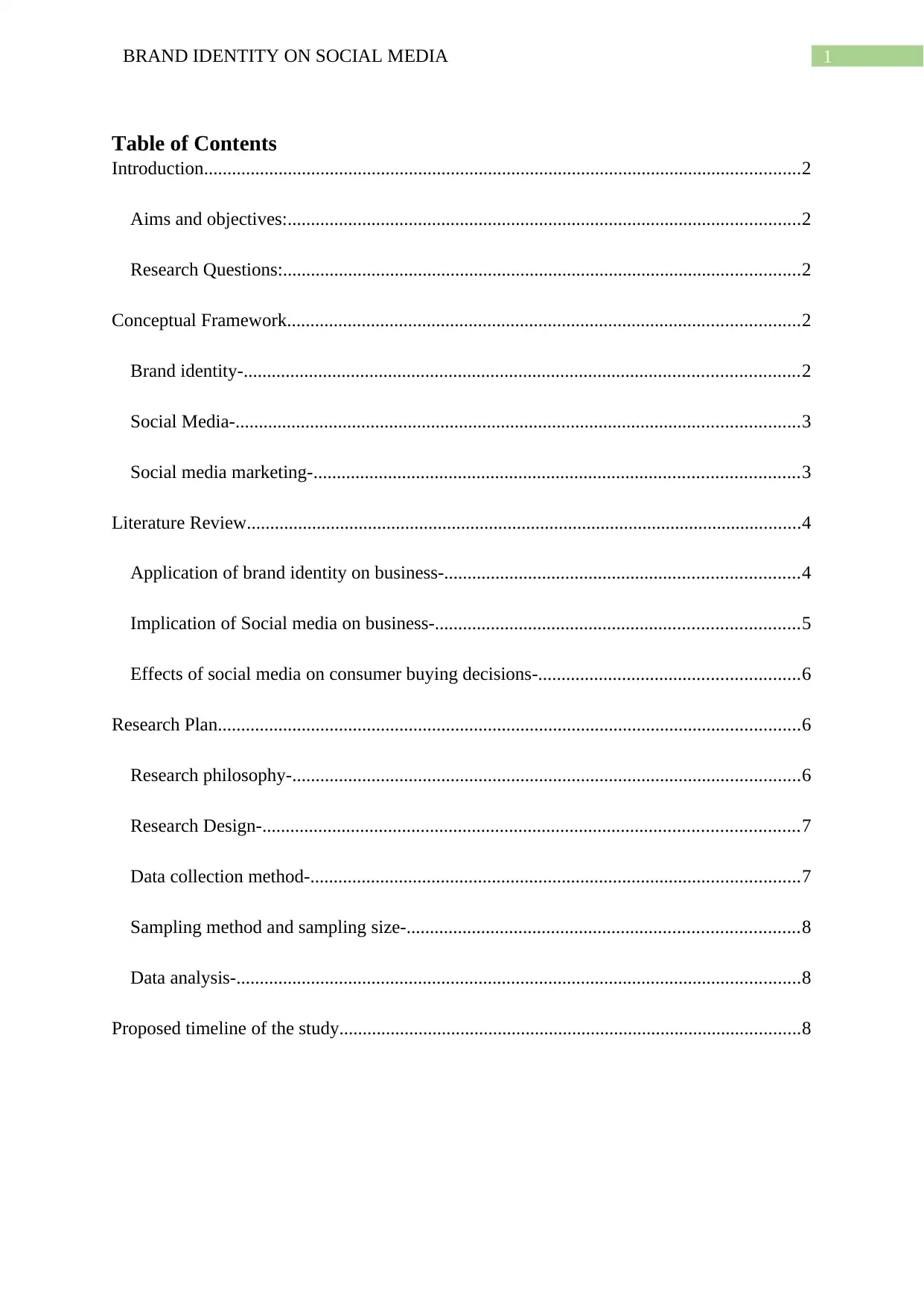
1BRAND IDENTITY ON SOCIAL MEDIA
Table of Contents
Introduction................................................................................................................................2
Aims and objectives:..............................................................................................................2
Research Questions:...............................................................................................................2
Conceptual Framework..............................................................................................................2
Brand identity-.......................................................................................................................2
Social Media-.........................................................................................................................3
Social media marketing-........................................................................................................3
Literature Review.......................................................................................................................4
Application of brand identity on business-............................................................................4
Implication of Social media on business-..............................................................................5
Effects of social media on consumer buying decisions-........................................................6
Research Plan.............................................................................................................................6
Research philosophy-.............................................................................................................6
Research Design-...................................................................................................................7
Data collection method-.........................................................................................................7
Sampling method and sampling size-....................................................................................8
Data analysis-.........................................................................................................................8
Proposed timeline of the study...................................................................................................8
Table of Contents
Introduction................................................................................................................................2
Aims and objectives:..............................................................................................................2
Research Questions:...............................................................................................................2
Conceptual Framework..............................................................................................................2
Brand identity-.......................................................................................................................2
Social Media-.........................................................................................................................3
Social media marketing-........................................................................................................3
Literature Review.......................................................................................................................4
Application of brand identity on business-............................................................................4
Implication of Social media on business-..............................................................................5
Effects of social media on consumer buying decisions-........................................................6
Research Plan.............................................................................................................................6
Research philosophy-.............................................................................................................6
Research Design-...................................................................................................................7
Data collection method-.........................................................................................................7
Sampling method and sampling size-....................................................................................8
Data analysis-.........................................................................................................................8
Proposed timeline of the study...................................................................................................8
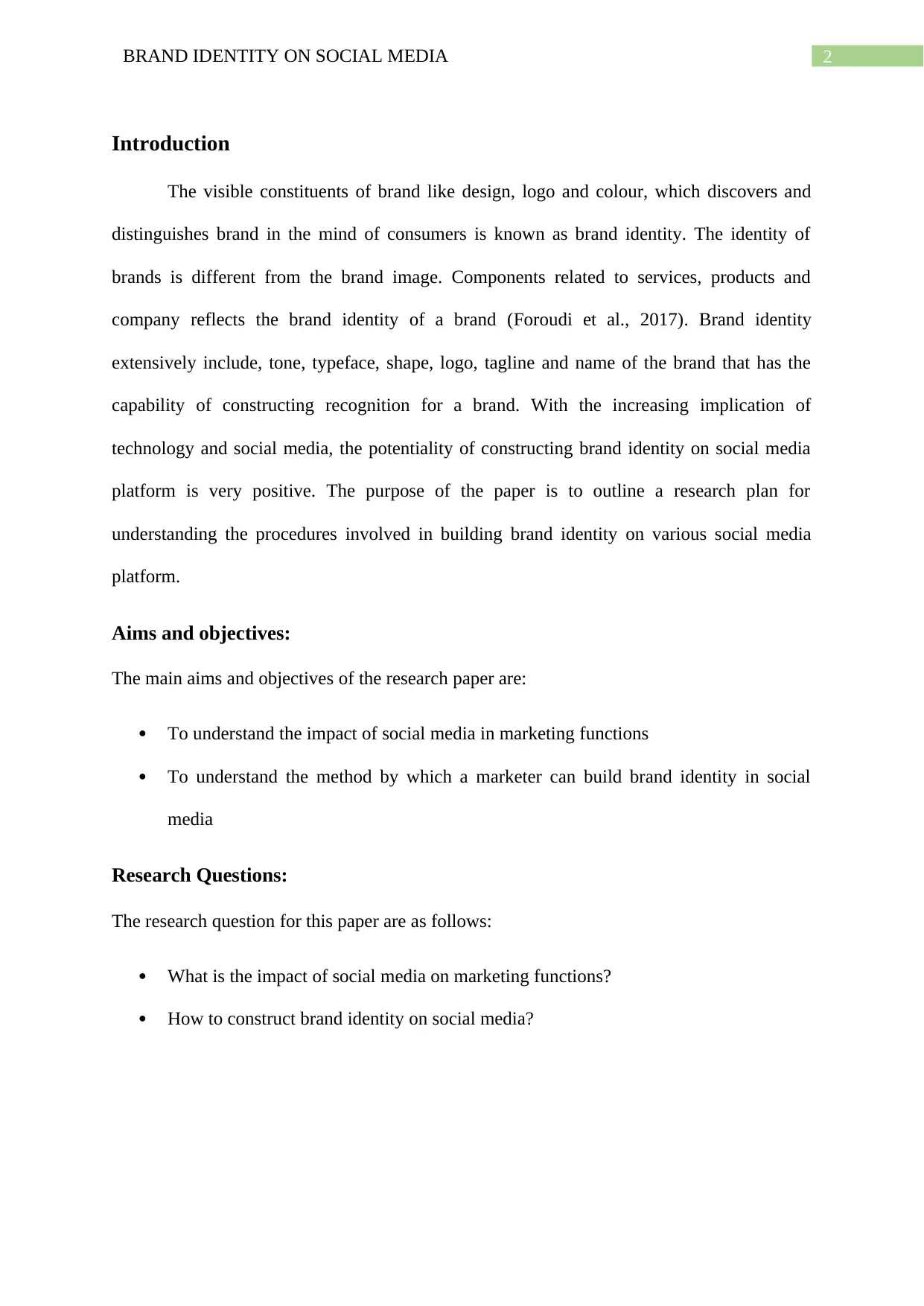
2BRAND IDENTITY ON SOCIAL MEDIA
Introduction
The visible constituents of brand like design, logo and colour, which discovers and
distinguishes brand in the mind of consumers is known as brand identity. The identity of
brands is different from the brand image. Components related to services, products and
company reflects the brand identity of a brand (Foroudi et al., 2017). Brand identity
extensively include, tone, typeface, shape, logo, tagline and name of the brand that has the
capability of constructing recognition for a brand. With the increasing implication of
technology and social media, the potentiality of constructing brand identity on social media
platform is very positive. The purpose of the paper is to outline a research plan for
understanding the procedures involved in building brand identity on various social media
platform.
Aims and objectives:
The main aims and objectives of the research paper are:
To understand the impact of social media in marketing functions
To understand the method by which a marketer can build brand identity in social
media
Research Questions:
The research question for this paper are as follows:
What is the impact of social media on marketing functions?
How to construct brand identity on social media?
Introduction
The visible constituents of brand like design, logo and colour, which discovers and
distinguishes brand in the mind of consumers is known as brand identity. The identity of
brands is different from the brand image. Components related to services, products and
company reflects the brand identity of a brand (Foroudi et al., 2017). Brand identity
extensively include, tone, typeface, shape, logo, tagline and name of the brand that has the
capability of constructing recognition for a brand. With the increasing implication of
technology and social media, the potentiality of constructing brand identity on social media
platform is very positive. The purpose of the paper is to outline a research plan for
understanding the procedures involved in building brand identity on various social media
platform.
Aims and objectives:
The main aims and objectives of the research paper are:
To understand the impact of social media in marketing functions
To understand the method by which a marketer can build brand identity in social
media
Research Questions:
The research question for this paper are as follows:
What is the impact of social media on marketing functions?
How to construct brand identity on social media?
⊘ This is a preview!⊘
Do you want full access?
Subscribe today to unlock all pages.

Trusted by 1+ million students worldwide
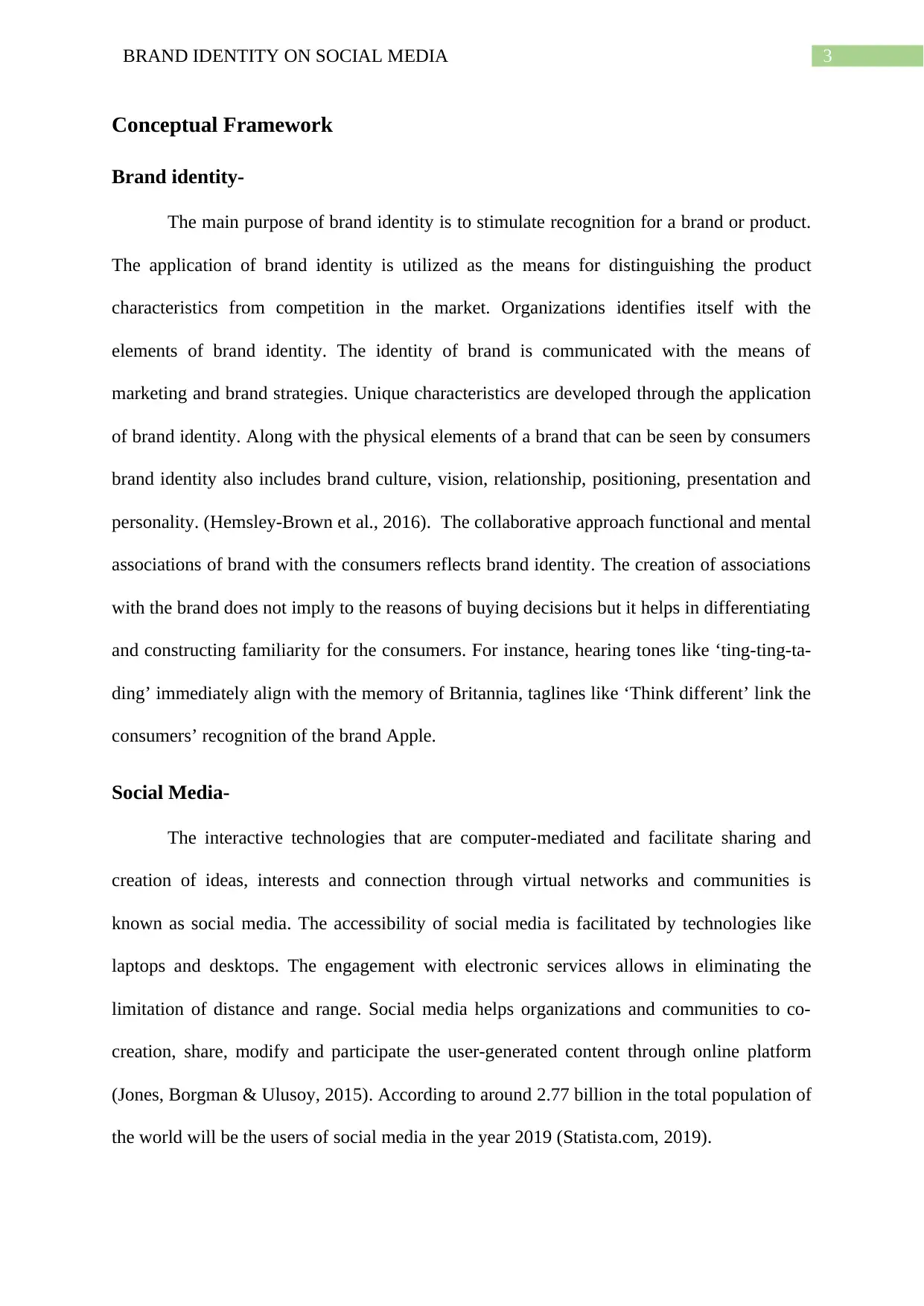
3BRAND IDENTITY ON SOCIAL MEDIA
Conceptual Framework
Brand identity-
The main purpose of brand identity is to stimulate recognition for a brand or product.
The application of brand identity is utilized as the means for distinguishing the product
characteristics from competition in the market. Organizations identifies itself with the
elements of brand identity. The identity of brand is communicated with the means of
marketing and brand strategies. Unique characteristics are developed through the application
of brand identity. Along with the physical elements of a brand that can be seen by consumers
brand identity also includes brand culture, vision, relationship, positioning, presentation and
personality. (Hemsley-Brown et al., 2016). The collaborative approach functional and mental
associations of brand with the consumers reflects brand identity. The creation of associations
with the brand does not imply to the reasons of buying decisions but it helps in differentiating
and constructing familiarity for the consumers. For instance, hearing tones like ‘ting-ting-ta-
ding’ immediately align with the memory of Britannia, taglines like ‘Think different’ link the
consumers’ recognition of the brand Apple.
Social Media-
The interactive technologies that are computer-mediated and facilitate sharing and
creation of ideas, interests and connection through virtual networks and communities is
known as social media. The accessibility of social media is facilitated by technologies like
laptops and desktops. The engagement with electronic services allows in eliminating the
limitation of distance and range. Social media helps organizations and communities to co-
creation, share, modify and participate the user-generated content through online platform
(Jones, Borgman & Ulusoy, 2015). According to around 2.77 billion in the total population of
the world will be the users of social media in the year 2019 (Statista.com, 2019).
Conceptual Framework
Brand identity-
The main purpose of brand identity is to stimulate recognition for a brand or product.
The application of brand identity is utilized as the means for distinguishing the product
characteristics from competition in the market. Organizations identifies itself with the
elements of brand identity. The identity of brand is communicated with the means of
marketing and brand strategies. Unique characteristics are developed through the application
of brand identity. Along with the physical elements of a brand that can be seen by consumers
brand identity also includes brand culture, vision, relationship, positioning, presentation and
personality. (Hemsley-Brown et al., 2016). The collaborative approach functional and mental
associations of brand with the consumers reflects brand identity. The creation of associations
with the brand does not imply to the reasons of buying decisions but it helps in differentiating
and constructing familiarity for the consumers. For instance, hearing tones like ‘ting-ting-ta-
ding’ immediately align with the memory of Britannia, taglines like ‘Think different’ link the
consumers’ recognition of the brand Apple.
Social Media-
The interactive technologies that are computer-mediated and facilitate sharing and
creation of ideas, interests and connection through virtual networks and communities is
known as social media. The accessibility of social media is facilitated by technologies like
laptops and desktops. The engagement with electronic services allows in eliminating the
limitation of distance and range. Social media helps organizations and communities to co-
creation, share, modify and participate the user-generated content through online platform
(Jones, Borgman & Ulusoy, 2015). According to around 2.77 billion in the total population of
the world will be the users of social media in the year 2019 (Statista.com, 2019).
Paraphrase This Document
Need a fresh take? Get an instant paraphrase of this document with our AI Paraphraser
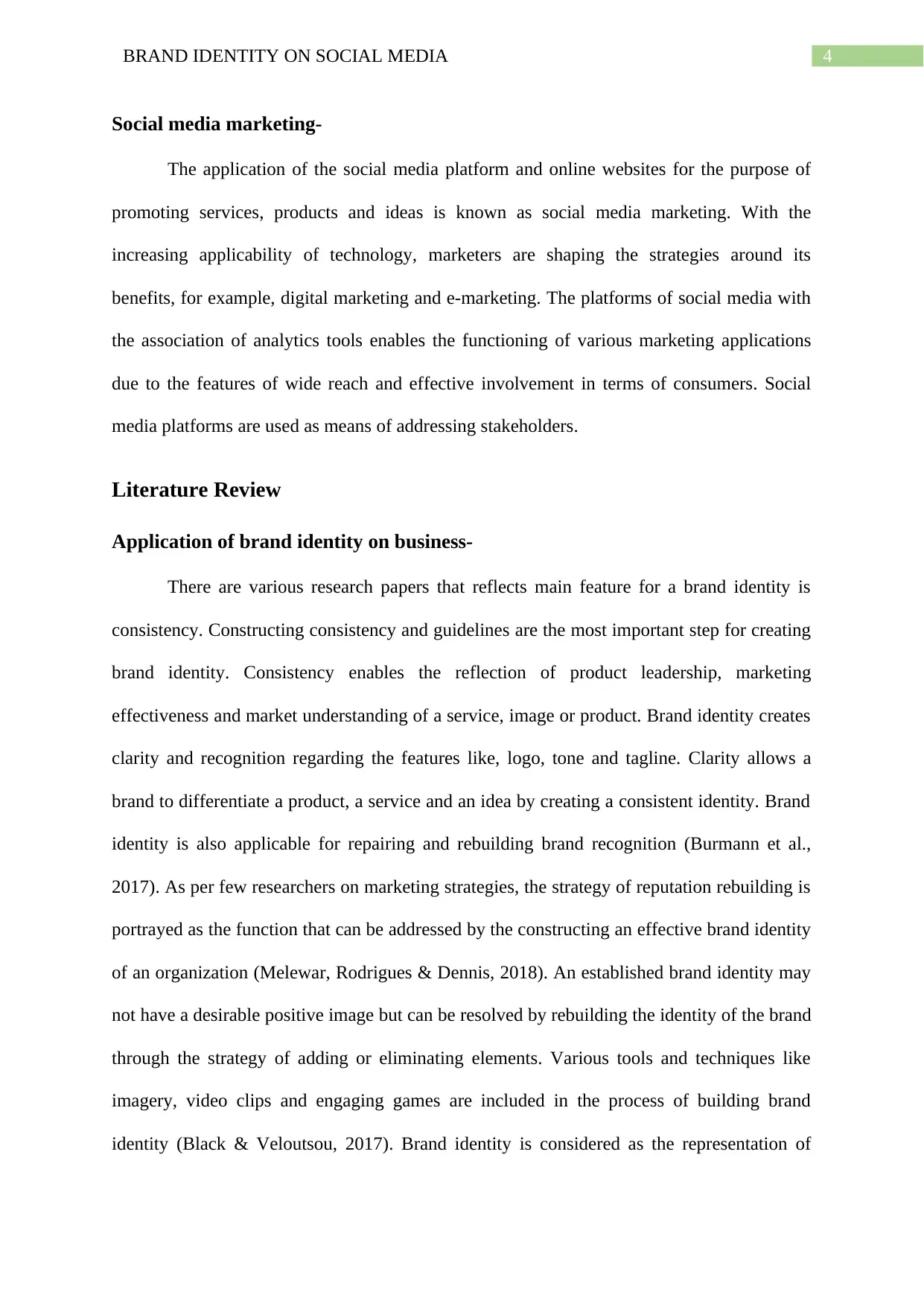
4BRAND IDENTITY ON SOCIAL MEDIA
Social media marketing-
The application of the social media platform and online websites for the purpose of
promoting services, products and ideas is known as social media marketing. With the
increasing applicability of technology, marketers are shaping the strategies around its
benefits, for example, digital marketing and e-marketing. The platforms of social media with
the association of analytics tools enables the functioning of various marketing applications
due to the features of wide reach and effective involvement in terms of consumers. Social
media platforms are used as means of addressing stakeholders.
Literature Review
Application of brand identity on business-
There are various research papers that reflects main feature for a brand identity is
consistency. Constructing consistency and guidelines are the most important step for creating
brand identity. Consistency enables the reflection of product leadership, marketing
effectiveness and market understanding of a service, image or product. Brand identity creates
clarity and recognition regarding the features like, logo, tone and tagline. Clarity allows a
brand to differentiate a product, a service and an idea by creating a consistent identity. Brand
identity is also applicable for repairing and rebuilding brand recognition (Burmann et al.,
2017). As per few researchers on marketing strategies, the strategy of reputation rebuilding is
portrayed as the function that can be addressed by the constructing an effective brand identity
of an organization (Melewar, Rodrigues & Dennis, 2018). An established brand identity may
not have a desirable positive image but can be resolved by rebuilding the identity of the brand
through the strategy of adding or eliminating elements. Various tools and techniques like
imagery, video clips and engaging games are included in the process of building brand
identity (Black & Veloutsou, 2017). Brand identity is considered as the representation of
Social media marketing-
The application of the social media platform and online websites for the purpose of
promoting services, products and ideas is known as social media marketing. With the
increasing applicability of technology, marketers are shaping the strategies around its
benefits, for example, digital marketing and e-marketing. The platforms of social media with
the association of analytics tools enables the functioning of various marketing applications
due to the features of wide reach and effective involvement in terms of consumers. Social
media platforms are used as means of addressing stakeholders.
Literature Review
Application of brand identity on business-
There are various research papers that reflects main feature for a brand identity is
consistency. Constructing consistency and guidelines are the most important step for creating
brand identity. Consistency enables the reflection of product leadership, marketing
effectiveness and market understanding of a service, image or product. Brand identity creates
clarity and recognition regarding the features like, logo, tone and tagline. Clarity allows a
brand to differentiate a product, a service and an idea by creating a consistent identity. Brand
identity is also applicable for repairing and rebuilding brand recognition (Burmann et al.,
2017). As per few researchers on marketing strategies, the strategy of reputation rebuilding is
portrayed as the function that can be addressed by the constructing an effective brand identity
of an organization (Melewar, Rodrigues & Dennis, 2018). An established brand identity may
not have a desirable positive image but can be resolved by rebuilding the identity of the brand
through the strategy of adding or eliminating elements. Various tools and techniques like
imagery, video clips and engaging games are included in the process of building brand
identity (Black & Veloutsou, 2017). Brand identity is considered as the representation of
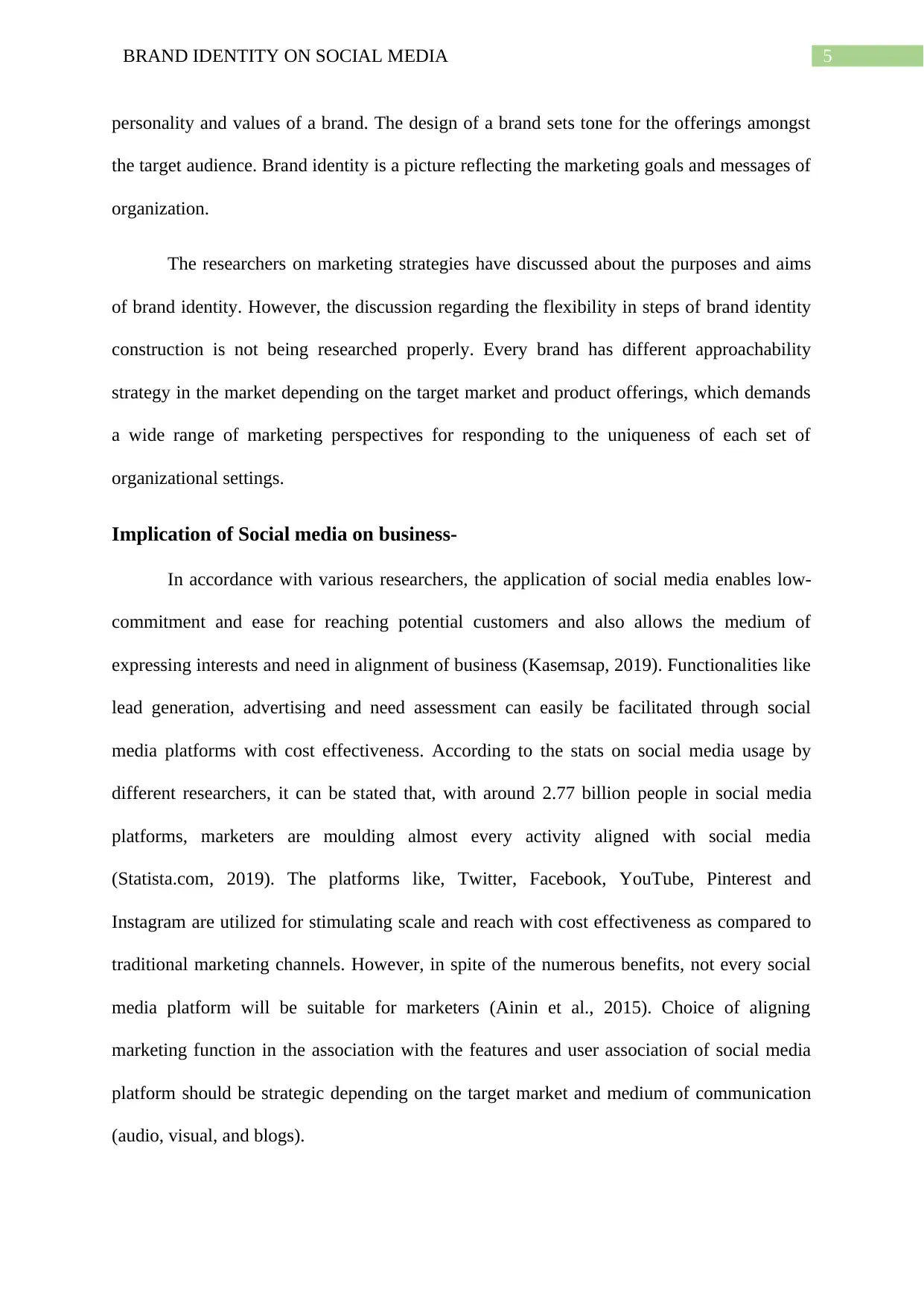
5BRAND IDENTITY ON SOCIAL MEDIA
personality and values of a brand. The design of a brand sets tone for the offerings amongst
the target audience. Brand identity is a picture reflecting the marketing goals and messages of
organization.
The researchers on marketing strategies have discussed about the purposes and aims
of brand identity. However, the discussion regarding the flexibility in steps of brand identity
construction is not being researched properly. Every brand has different approachability
strategy in the market depending on the target market and product offerings, which demands
a wide range of marketing perspectives for responding to the uniqueness of each set of
organizational settings.
Implication of Social media on business-
In accordance with various researchers, the application of social media enables low-
commitment and ease for reaching potential customers and also allows the medium of
expressing interests and need in alignment of business (Kasemsap, 2019). Functionalities like
lead generation, advertising and need assessment can easily be facilitated through social
media platforms with cost effectiveness. According to the stats on social media usage by
different researchers, it can be stated that, with around 2.77 billion people in social media
platforms, marketers are moulding almost every activity aligned with social media
(Statista.com, 2019). The platforms like, Twitter, Facebook, YouTube, Pinterest and
Instagram are utilized for stimulating scale and reach with cost effectiveness as compared to
traditional marketing channels. However, in spite of the numerous benefits, not every social
media platform will be suitable for marketers (Ainin et al., 2015). Choice of aligning
marketing function in the association with the features and user association of social media
platform should be strategic depending on the target market and medium of communication
(audio, visual, and blogs).
personality and values of a brand. The design of a brand sets tone for the offerings amongst
the target audience. Brand identity is a picture reflecting the marketing goals and messages of
organization.
The researchers on marketing strategies have discussed about the purposes and aims
of brand identity. However, the discussion regarding the flexibility in steps of brand identity
construction is not being researched properly. Every brand has different approachability
strategy in the market depending on the target market and product offerings, which demands
a wide range of marketing perspectives for responding to the uniqueness of each set of
organizational settings.
Implication of Social media on business-
In accordance with various researchers, the application of social media enables low-
commitment and ease for reaching potential customers and also allows the medium of
expressing interests and need in alignment of business (Kasemsap, 2019). Functionalities like
lead generation, advertising and need assessment can easily be facilitated through social
media platforms with cost effectiveness. According to the stats on social media usage by
different researchers, it can be stated that, with around 2.77 billion people in social media
platforms, marketers are moulding almost every activity aligned with social media
(Statista.com, 2019). The platforms like, Twitter, Facebook, YouTube, Pinterest and
Instagram are utilized for stimulating scale and reach with cost effectiveness as compared to
traditional marketing channels. However, in spite of the numerous benefits, not every social
media platform will be suitable for marketers (Ainin et al., 2015). Choice of aligning
marketing function in the association with the features and user association of social media
platform should be strategic depending on the target market and medium of communication
(audio, visual, and blogs).
⊘ This is a preview!⊘
Do you want full access?
Subscribe today to unlock all pages.

Trusted by 1+ million students worldwide
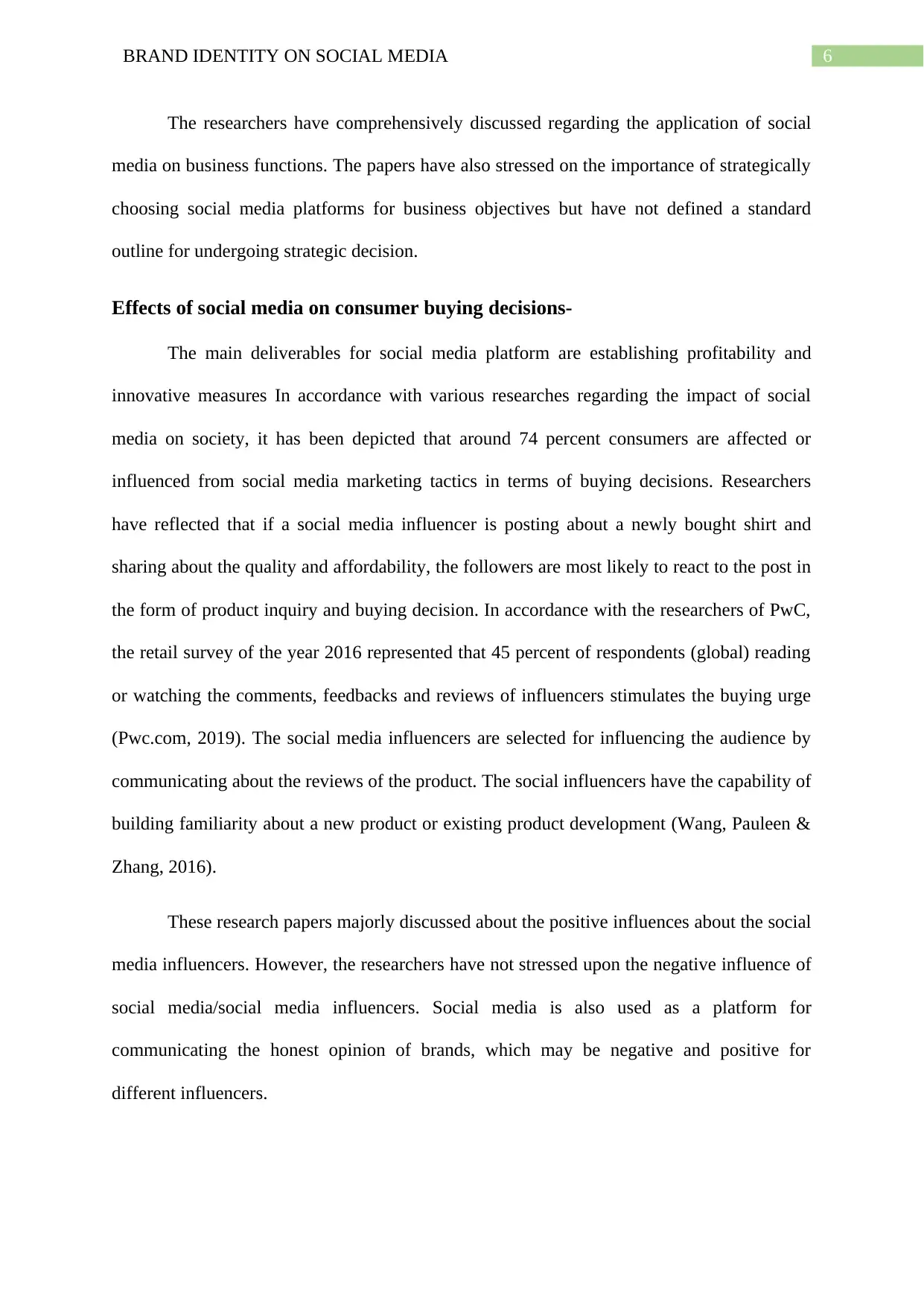
6BRAND IDENTITY ON SOCIAL MEDIA
The researchers have comprehensively discussed regarding the application of social
media on business functions. The papers have also stressed on the importance of strategically
choosing social media platforms for business objectives but have not defined a standard
outline for undergoing strategic decision.
Effects of social media on consumer buying decisions-
The main deliverables for social media platform are establishing profitability and
innovative measures In accordance with various researches regarding the impact of social
media on society, it has been depicted that around 74 percent consumers are affected or
influenced from social media marketing tactics in terms of buying decisions. Researchers
have reflected that if a social media influencer is posting about a newly bought shirt and
sharing about the quality and affordability, the followers are most likely to react to the post in
the form of product inquiry and buying decision. In accordance with the researchers of PwC,
the retail survey of the year 2016 represented that 45 percent of respondents (global) reading
or watching the comments, feedbacks and reviews of influencers stimulates the buying urge
(Pwc.com, 2019). The social media influencers are selected for influencing the audience by
communicating about the reviews of the product. The social influencers have the capability of
building familiarity about a new product or existing product development (Wang, Pauleen &
Zhang, 2016).
These research papers majorly discussed about the positive influences about the social
media influencers. However, the researchers have not stressed upon the negative influence of
social media/social media influencers. Social media is also used as a platform for
communicating the honest opinion of brands, which may be negative and positive for
different influencers.
The researchers have comprehensively discussed regarding the application of social
media on business functions. The papers have also stressed on the importance of strategically
choosing social media platforms for business objectives but have not defined a standard
outline for undergoing strategic decision.
Effects of social media on consumer buying decisions-
The main deliverables for social media platform are establishing profitability and
innovative measures In accordance with various researches regarding the impact of social
media on society, it has been depicted that around 74 percent consumers are affected or
influenced from social media marketing tactics in terms of buying decisions. Researchers
have reflected that if a social media influencer is posting about a newly bought shirt and
sharing about the quality and affordability, the followers are most likely to react to the post in
the form of product inquiry and buying decision. In accordance with the researchers of PwC,
the retail survey of the year 2016 represented that 45 percent of respondents (global) reading
or watching the comments, feedbacks and reviews of influencers stimulates the buying urge
(Pwc.com, 2019). The social media influencers are selected for influencing the audience by
communicating about the reviews of the product. The social influencers have the capability of
building familiarity about a new product or existing product development (Wang, Pauleen &
Zhang, 2016).
These research papers majorly discussed about the positive influences about the social
media influencers. However, the researchers have not stressed upon the negative influence of
social media/social media influencers. Social media is also used as a platform for
communicating the honest opinion of brands, which may be negative and positive for
different influencers.
Paraphrase This Document
Need a fresh take? Get an instant paraphrase of this document with our AI Paraphraser
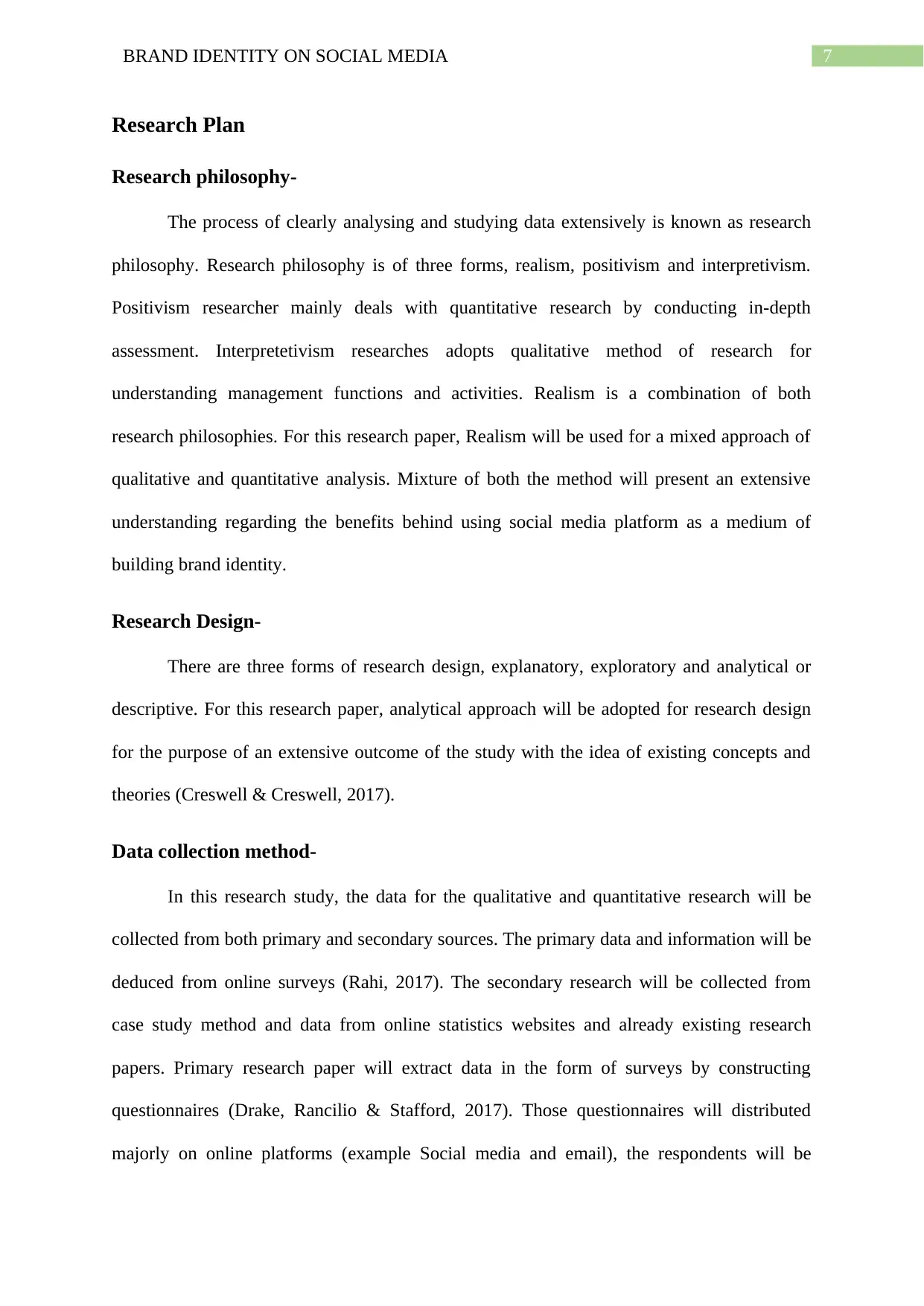
7BRAND IDENTITY ON SOCIAL MEDIA
Research Plan
Research philosophy-
The process of clearly analysing and studying data extensively is known as research
philosophy. Research philosophy is of three forms, realism, positivism and interpretivism.
Positivism researcher mainly deals with quantitative research by conducting in-depth
assessment. Interpretetivism researches adopts qualitative method of research for
understanding management functions and activities. Realism is a combination of both
research philosophies. For this research paper, Realism will be used for a mixed approach of
qualitative and quantitative analysis. Mixture of both the method will present an extensive
understanding regarding the benefits behind using social media platform as a medium of
building brand identity.
Research Design-
There are three forms of research design, explanatory, exploratory and analytical or
descriptive. For this research paper, analytical approach will be adopted for research design
for the purpose of an extensive outcome of the study with the idea of existing concepts and
theories (Creswell & Creswell, 2017).
Data collection method-
In this research study, the data for the qualitative and quantitative research will be
collected from both primary and secondary sources. The primary data and information will be
deduced from online surveys (Rahi, 2017). The secondary research will be collected from
case study method and data from online statistics websites and already existing research
papers. Primary research paper will extract data in the form of surveys by constructing
questionnaires (Drake, Rancilio & Stafford, 2017). Those questionnaires will distributed
majorly on online platforms (example Social media and email), the respondents will be
Research Plan
Research philosophy-
The process of clearly analysing and studying data extensively is known as research
philosophy. Research philosophy is of three forms, realism, positivism and interpretivism.
Positivism researcher mainly deals with quantitative research by conducting in-depth
assessment. Interpretetivism researches adopts qualitative method of research for
understanding management functions and activities. Realism is a combination of both
research philosophies. For this research paper, Realism will be used for a mixed approach of
qualitative and quantitative analysis. Mixture of both the method will present an extensive
understanding regarding the benefits behind using social media platform as a medium of
building brand identity.
Research Design-
There are three forms of research design, explanatory, exploratory and analytical or
descriptive. For this research paper, analytical approach will be adopted for research design
for the purpose of an extensive outcome of the study with the idea of existing concepts and
theories (Creswell & Creswell, 2017).
Data collection method-
In this research study, the data for the qualitative and quantitative research will be
collected from both primary and secondary sources. The primary data and information will be
deduced from online surveys (Rahi, 2017). The secondary research will be collected from
case study method and data from online statistics websites and already existing research
papers. Primary research paper will extract data in the form of surveys by constructing
questionnaires (Drake, Rancilio & Stafford, 2017). Those questionnaires will distributed
majorly on online platforms (example Social media and email), the respondents will be
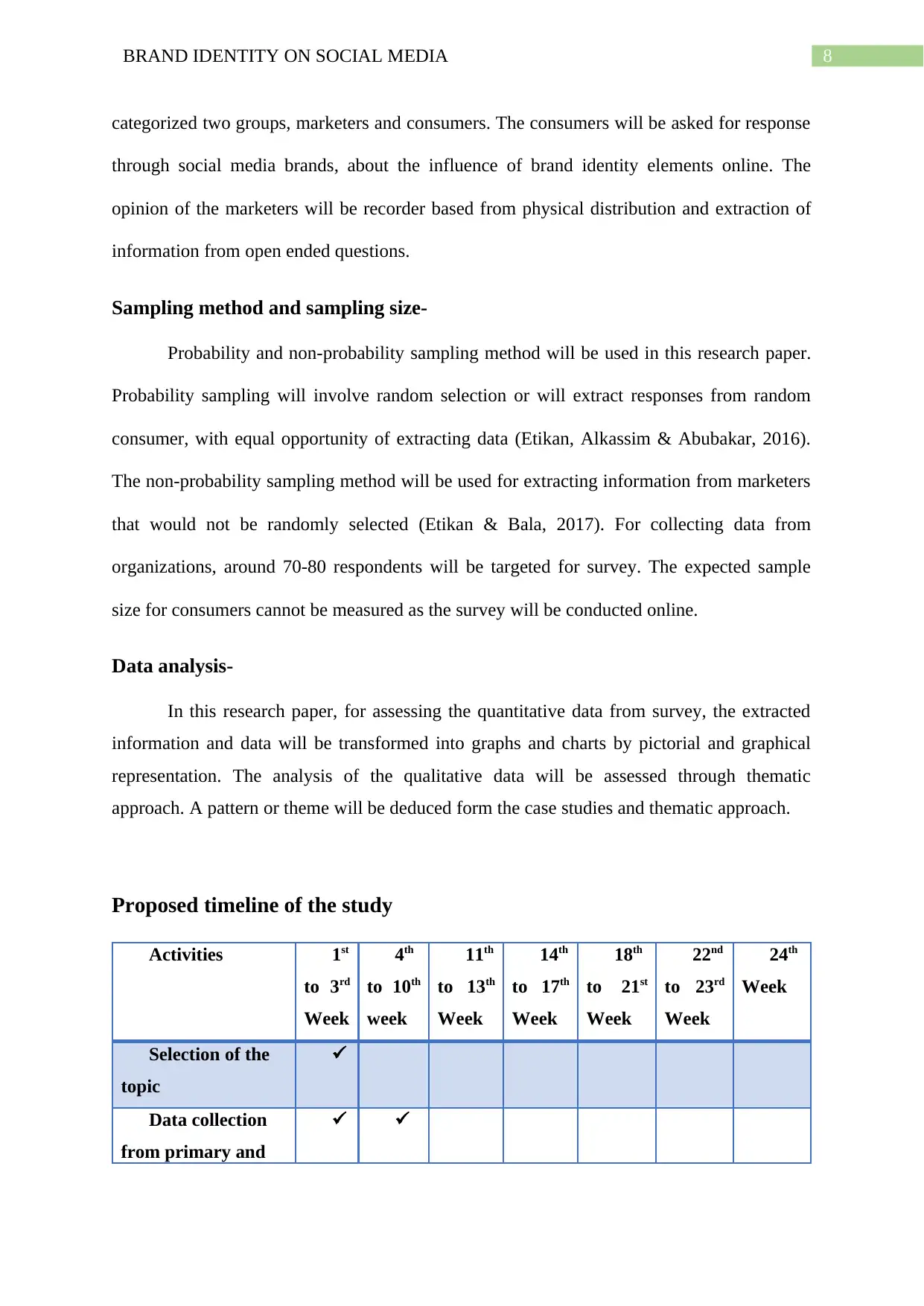
8BRAND IDENTITY ON SOCIAL MEDIA
categorized two groups, marketers and consumers. The consumers will be asked for response
through social media brands, about the influence of brand identity elements online. The
opinion of the marketers will be recorder based from physical distribution and extraction of
information from open ended questions.
Sampling method and sampling size-
Probability and non-probability sampling method will be used in this research paper.
Probability sampling will involve random selection or will extract responses from random
consumer, with equal opportunity of extracting data (Etikan, Alkassim & Abubakar, 2016).
The non-probability sampling method will be used for extracting information from marketers
that would not be randomly selected (Etikan & Bala, 2017). For collecting data from
organizations, around 70-80 respondents will be targeted for survey. The expected sample
size for consumers cannot be measured as the survey will be conducted online.
Data analysis-
In this research paper, for assessing the quantitative data from survey, the extracted
information and data will be transformed into graphs and charts by pictorial and graphical
representation. The analysis of the qualitative data will be assessed through thematic
approach. A pattern or theme will be deduced form the case studies and thematic approach.
Proposed timeline of the study
Activities 1st
to 3rd
Week
4th
to 10th
week
11th
to 13th
Week
14th
to 17th
Week
18th
to 21st
Week
22nd
to 23rd
Week
24th
Week
Selection of the
topic
Data collection
from primary and
categorized two groups, marketers and consumers. The consumers will be asked for response
through social media brands, about the influence of brand identity elements online. The
opinion of the marketers will be recorder based from physical distribution and extraction of
information from open ended questions.
Sampling method and sampling size-
Probability and non-probability sampling method will be used in this research paper.
Probability sampling will involve random selection or will extract responses from random
consumer, with equal opportunity of extracting data (Etikan, Alkassim & Abubakar, 2016).
The non-probability sampling method will be used for extracting information from marketers
that would not be randomly selected (Etikan & Bala, 2017). For collecting data from
organizations, around 70-80 respondents will be targeted for survey. The expected sample
size for consumers cannot be measured as the survey will be conducted online.
Data analysis-
In this research paper, for assessing the quantitative data from survey, the extracted
information and data will be transformed into graphs and charts by pictorial and graphical
representation. The analysis of the qualitative data will be assessed through thematic
approach. A pattern or theme will be deduced form the case studies and thematic approach.
Proposed timeline of the study
Activities 1st
to 3rd
Week
4th
to 10th
week
11th
to 13th
Week
14th
to 17th
Week
18th
to 21st
Week
22nd
to 23rd
Week
24th
Week
Selection of the
topic
Data collection
from primary and
⊘ This is a preview!⊘
Do you want full access?
Subscribe today to unlock all pages.

Trusted by 1+ million students worldwide
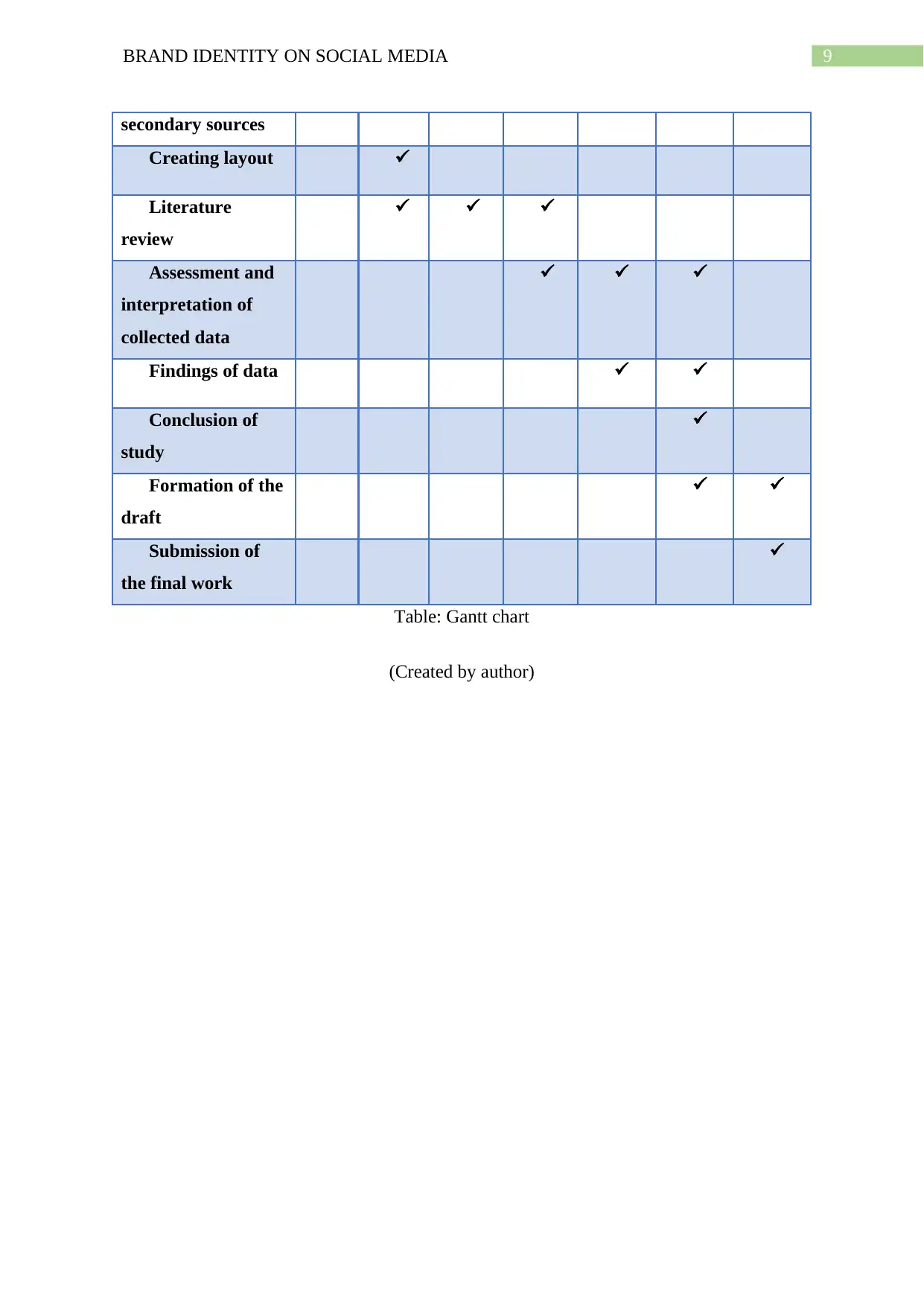
9BRAND IDENTITY ON SOCIAL MEDIA
secondary sources
Creating layout
Literature
review
Assessment and
interpretation of
collected data
Findings of data
Conclusion of
study
Formation of the
draft
Submission of
the final work
Table: Gantt chart
(Created by author)
secondary sources
Creating layout
Literature
review
Assessment and
interpretation of
collected data
Findings of data
Conclusion of
study
Formation of the
draft
Submission of
the final work
Table: Gantt chart
(Created by author)
Paraphrase This Document
Need a fresh take? Get an instant paraphrase of this document with our AI Paraphraser
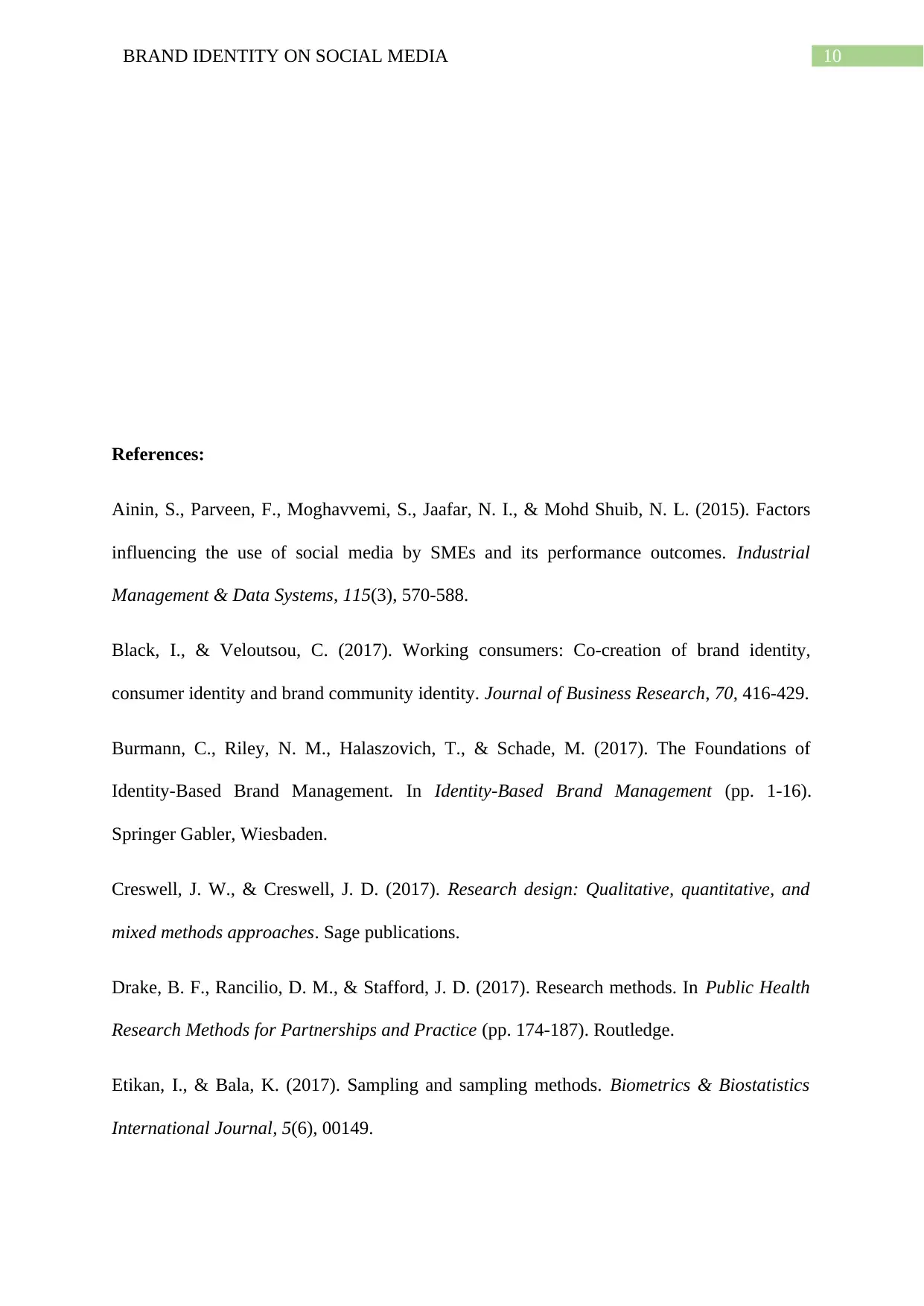
10BRAND IDENTITY ON SOCIAL MEDIA
References:
Ainin, S., Parveen, F., Moghavvemi, S., Jaafar, N. I., & Mohd Shuib, N. L. (2015). Factors
influencing the use of social media by SMEs and its performance outcomes. Industrial
Management & Data Systems, 115(3), 570-588.
Black, I., & Veloutsou, C. (2017). Working consumers: Co-creation of brand identity,
consumer identity and brand community identity. Journal of Business Research, 70, 416-429.
Burmann, C., Riley, N. M., Halaszovich, T., & Schade, M. (2017). The Foundations of
Identity-Based Brand Management. In Identity-Based Brand Management (pp. 1-16).
Springer Gabler, Wiesbaden.
Creswell, J. W., & Creswell, J. D. (2017). Research design: Qualitative, quantitative, and
mixed methods approaches. Sage publications.
Drake, B. F., Rancilio, D. M., & Stafford, J. D. (2017). Research methods. In Public Health
Research Methods for Partnerships and Practice (pp. 174-187). Routledge.
Etikan, I., & Bala, K. (2017). Sampling and sampling methods. Biometrics & Biostatistics
International Journal, 5(6), 00149.
References:
Ainin, S., Parveen, F., Moghavvemi, S., Jaafar, N. I., & Mohd Shuib, N. L. (2015). Factors
influencing the use of social media by SMEs and its performance outcomes. Industrial
Management & Data Systems, 115(3), 570-588.
Black, I., & Veloutsou, C. (2017). Working consumers: Co-creation of brand identity,
consumer identity and brand community identity. Journal of Business Research, 70, 416-429.
Burmann, C., Riley, N. M., Halaszovich, T., & Schade, M. (2017). The Foundations of
Identity-Based Brand Management. In Identity-Based Brand Management (pp. 1-16).
Springer Gabler, Wiesbaden.
Creswell, J. W., & Creswell, J. D. (2017). Research design: Qualitative, quantitative, and
mixed methods approaches. Sage publications.
Drake, B. F., Rancilio, D. M., & Stafford, J. D. (2017). Research methods. In Public Health
Research Methods for Partnerships and Practice (pp. 174-187). Routledge.
Etikan, I., & Bala, K. (2017). Sampling and sampling methods. Biometrics & Biostatistics
International Journal, 5(6), 00149.
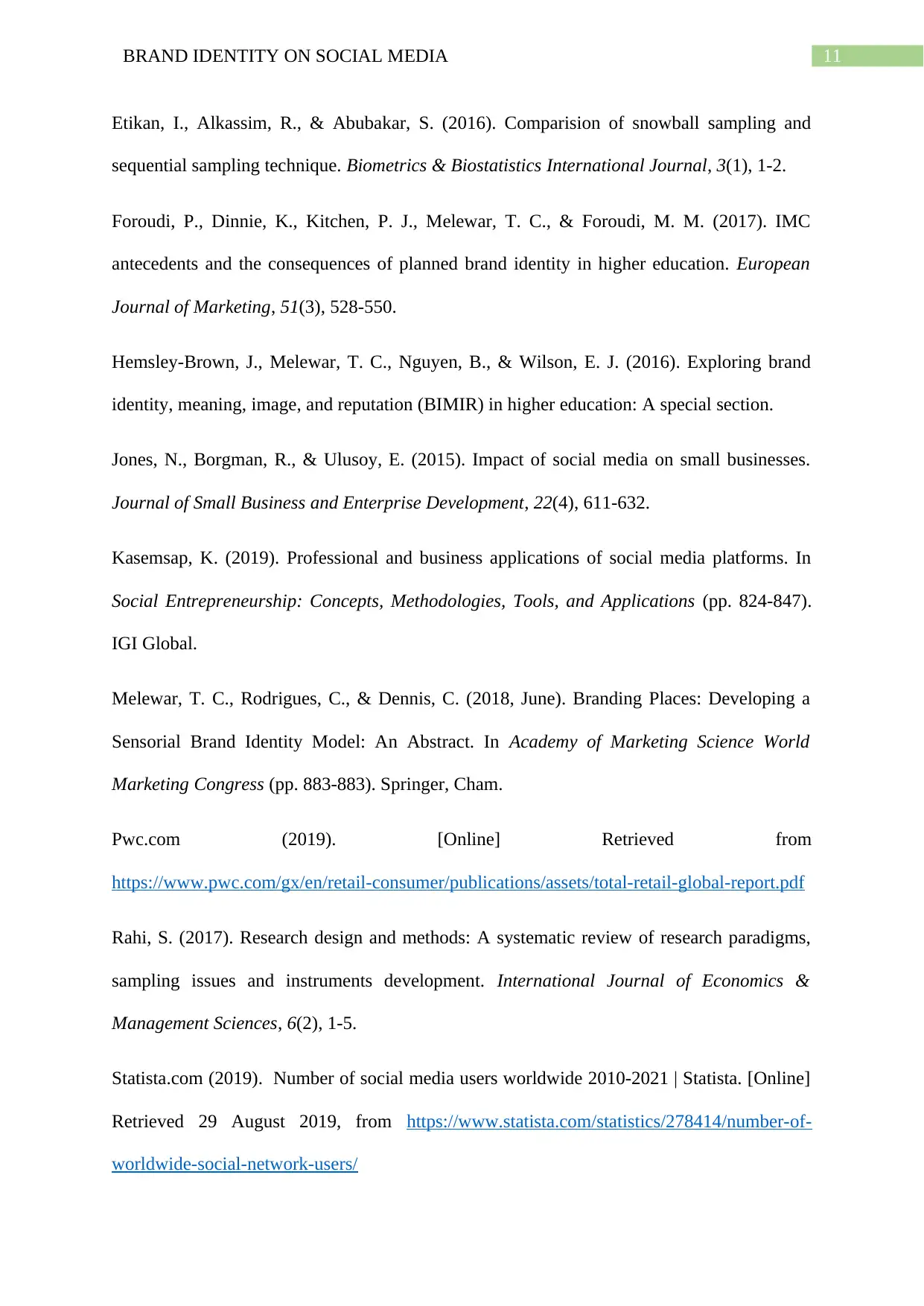
11BRAND IDENTITY ON SOCIAL MEDIA
Etikan, I., Alkassim, R., & Abubakar, S. (2016). Comparision of snowball sampling and
sequential sampling technique. Biometrics & Biostatistics International Journal, 3(1), 1-2.
Foroudi, P., Dinnie, K., Kitchen, P. J., Melewar, T. C., & Foroudi, M. M. (2017). IMC
antecedents and the consequences of planned brand identity in higher education. European
Journal of Marketing, 51(3), 528-550.
Hemsley-Brown, J., Melewar, T. C., Nguyen, B., & Wilson, E. J. (2016). Exploring brand
identity, meaning, image, and reputation (BIMIR) in higher education: A special section.
Jones, N., Borgman, R., & Ulusoy, E. (2015). Impact of social media on small businesses.
Journal of Small Business and Enterprise Development, 22(4), 611-632.
Kasemsap, K. (2019). Professional and business applications of social media platforms. In
Social Entrepreneurship: Concepts, Methodologies, Tools, and Applications (pp. 824-847).
IGI Global.
Melewar, T. C., Rodrigues, C., & Dennis, C. (2018, June). Branding Places: Developing a
Sensorial Brand Identity Model: An Abstract. In Academy of Marketing Science World
Marketing Congress (pp. 883-883). Springer, Cham.
Pwc.com (2019). [Online] Retrieved from
https://www.pwc.com/gx/en/retail-consumer/publications/assets/total-retail-global-report.pdf
Rahi, S. (2017). Research design and methods: A systematic review of research paradigms,
sampling issues and instruments development. International Journal of Economics &
Management Sciences, 6(2), 1-5.
Statista.com (2019). Number of social media users worldwide 2010-2021 | Statista. [Online]
Retrieved 29 August 2019, from https://www.statista.com/statistics/278414/number-of-
worldwide-social-network-users/
Etikan, I., Alkassim, R., & Abubakar, S. (2016). Comparision of snowball sampling and
sequential sampling technique. Biometrics & Biostatistics International Journal, 3(1), 1-2.
Foroudi, P., Dinnie, K., Kitchen, P. J., Melewar, T. C., & Foroudi, M. M. (2017). IMC
antecedents and the consequences of planned brand identity in higher education. European
Journal of Marketing, 51(3), 528-550.
Hemsley-Brown, J., Melewar, T. C., Nguyen, B., & Wilson, E. J. (2016). Exploring brand
identity, meaning, image, and reputation (BIMIR) in higher education: A special section.
Jones, N., Borgman, R., & Ulusoy, E. (2015). Impact of social media on small businesses.
Journal of Small Business and Enterprise Development, 22(4), 611-632.
Kasemsap, K. (2019). Professional and business applications of social media platforms. In
Social Entrepreneurship: Concepts, Methodologies, Tools, and Applications (pp. 824-847).
IGI Global.
Melewar, T. C., Rodrigues, C., & Dennis, C. (2018, June). Branding Places: Developing a
Sensorial Brand Identity Model: An Abstract. In Academy of Marketing Science World
Marketing Congress (pp. 883-883). Springer, Cham.
Pwc.com (2019). [Online] Retrieved from
https://www.pwc.com/gx/en/retail-consumer/publications/assets/total-retail-global-report.pdf
Rahi, S. (2017). Research design and methods: A systematic review of research paradigms,
sampling issues and instruments development. International Journal of Economics &
Management Sciences, 6(2), 1-5.
Statista.com (2019). Number of social media users worldwide 2010-2021 | Statista. [Online]
Retrieved 29 August 2019, from https://www.statista.com/statistics/278414/number-of-
worldwide-social-network-users/
⊘ This is a preview!⊘
Do you want full access?
Subscribe today to unlock all pages.

Trusted by 1+ million students worldwide
1 out of 13
Related Documents
Your All-in-One AI-Powered Toolkit for Academic Success.
+13062052269
info@desklib.com
Available 24*7 on WhatsApp / Email
![[object Object]](/_next/static/media/star-bottom.7253800d.svg)
Unlock your academic potential
Copyright © 2020–2025 A2Z Services. All Rights Reserved. Developed and managed by ZUCOL.




